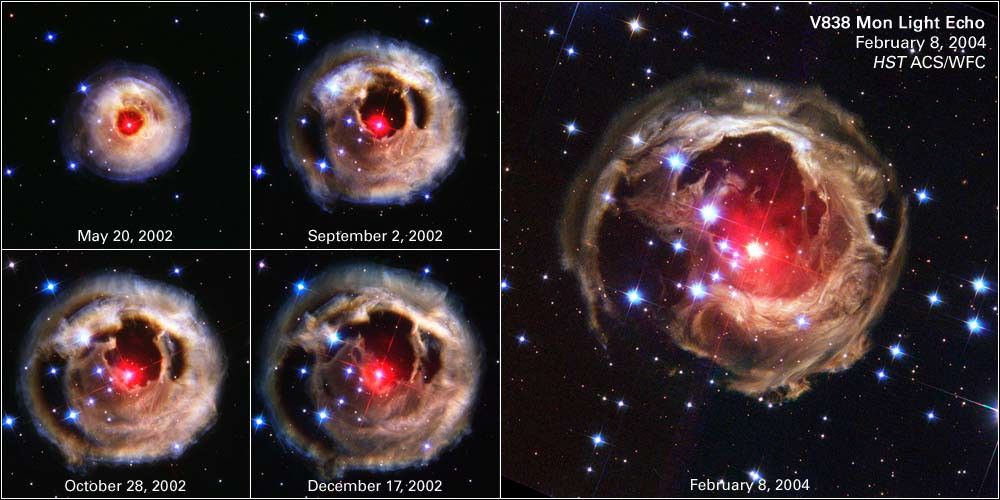1 min read
“Light Echo” Illuminates Dust Around Supergiant Star V838 Monocerotis (V838 Mon)

"Starry Night," Vincent van Gogh's famous painting, is renowned for its bold whorls of light sweeping across a raging night sky. Although this image of the heavens came only from the artist's restless imagination, a new picture from NASA's Hubble Space Telescope bears remarkable similarities to the van Gogh work, complete with never-before-seen spirals of dust swirling across trillions of miles of interstellar space.
This image, obtained with the Advanced Camera for Surveys on February 8, 2004, is Hubble's latest view of an expanding halo of light around a distant star, named V838 Monocerotis (V838 Mon). The illumination of interstellar dust comes from the red supergiant star at the middle of the image, which gave off a flashbulb-like pulse of light two years ago. V838 Mon is located about 20,000 light-years away from Earth in the direction of the constellation Monoceros, placing the star at the outer edge of our Milky Way galaxy.
Called a light echo, the expanding illumination of a dusty cloud around the star has been revealing remarkable structures ever since the star suddenly brightened for several weeks in early 2002. Though Hubble has followed the light echo in several snapshots, this new image shows swirls or eddies in the dusty cloud for the first time. These eddies are probably caused by turbulence in the dust and gas around the star as they slowly expand away. The dust and gas were likely ejected from the star in a previous explosion, similar to the 2002 event, which occurred some tens of thousands of years ago. The surrounding dust remained invisible and unsuspected until suddenly illuminated by the brilliant explosion of the central star two years ago.
The Hubble telescope has imaged V838 Mon and its light echo several times since the star's outburst in January 2002, in order to follow the constantly changing appearance of the dust as the pulse of illumination continues to expand away from the star at the speed of light. During the outburst event, the normally faint star suddenly brightened, becoming 600,000 times more luminous than our Sun. It was thus one of the brightest stars in the entire Milky Way, until it faded away again in April 2002. The star has some similarities to a class of objects called "novae," which suddenly increase in brightness due to thermonuclear explosions at their surfaces; however, the detailed behavior of V838 Mon, in particular its extremely red color, has been completely different from any previously known nova.
Nature's own piece of performance art, this structure will continue to change its appearance in coming years as the light from the stellar outburst continues to propagate outward and bounce off more distant black clouds of dust. Astronomers expect the echoes to remain visible for at least the rest of the current decade.
About the Object
- R.A. PositionR.A. PositionRight ascension – analogous to longitude – is one component of an object's position.07h 4m 4.99s
- Dec. PositionDec. PositionDeclination – analogous to latitude – is one component of an object's position.-3° 50' 50.0"
- ConstellationConstellationOne of 88 recognized regions of the celestial sphere in which the object appears.Monoceros
- DistanceDistanceThe physical distance from Earth to the astronomical object. Distances within our solar system are usually measured in Astronomical Units (AU). Distances between stars are usually measured in light-years. Interstellar distances can also be measured in parsecs.The star is ~20,000 light-years (~6 kiloparsecs) away.
- DimensionsDimensionsThe physical size of the object or the apparent angle it subtends on the sky.This image is 2.4 arcminutes (13.6 light-years or 4.2 parsecs) wide.
About the Data
- Data DescriptionData DescriptionProposal: A description of the observations, their scientific justification, and the links to the data available in the science archive.
Science Team: The astronomers who planned the observations and analyzed the data. "PI" refers to the Principal Investigator.These data are from the HST program 10089: K. Noll, H. Bond, C. Christian, L. Frattare, F. Hamilton, Z. Levay, M. Mutchler, and T. Royle (STScI). - InstrumentInstrumentThe science instrument used to produce the data.HST>ACS/WFC
- Exposure DatesExposure DatesThe date(s) that the telescope made its observations and the total exposure time.February 8, 2004, Exposure Time: 1.8 hours
- FiltersFiltersThe camera filters that were used in the science observations.F435W (B), F606W (V), F814W (I)
- Object NameObject NameA name or catalog number that astronomers use to identify an astronomical object.V838 Monocerotis, V838 Mon
- Object DescriptionObject DescriptionThe type of astronomical object.Nova-like variable star and surrounding light echo
- Release DateMarch 4, 2004
- Science ReleaseSpace Phenomenon Imitates Art in Universe’s Version of van Gogh Painting
- Credit

Blue" F435W (B) Green: F606W (V) Red: F814W (I)

Related Images & Videos
Share
Details
Claire Andreoli
NASA’s Goddard Space Flight Center
Greenbelt, Maryland
claire.andreoli@nasa.gov




































